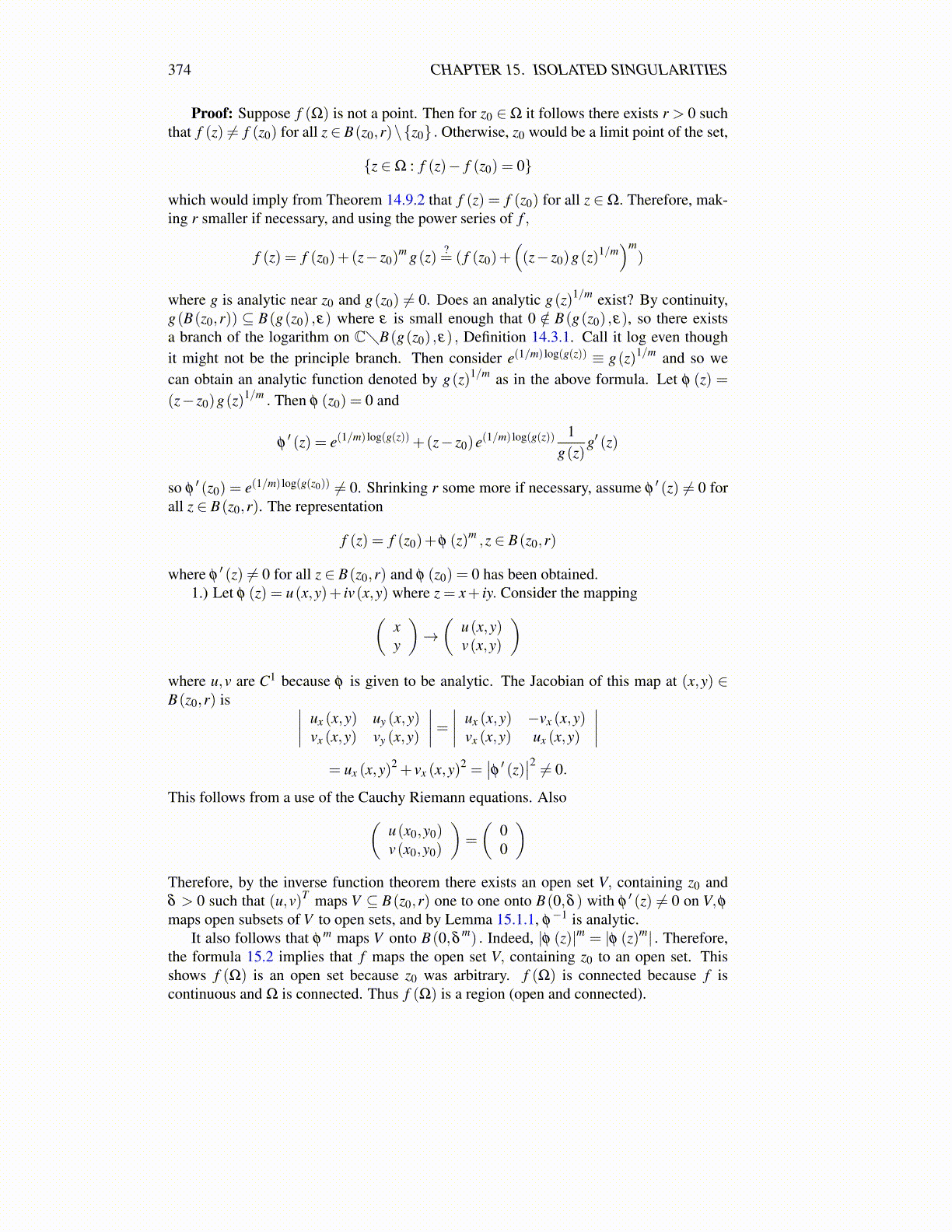
374 CHAPTER 15. ISOLATED SINGULARITIES
Proof: Suppose f (Ω) is not a point. Then for z0 ∈Ω it follows there exists r > 0 suchthat f (z) ̸= f (z0) for all z ∈ B(z0,r)\{z0} . Otherwise, z0 would be a limit point of the set,
{z ∈Ω : f (z)− f (z0) = 0}
which would imply from Theorem 14.9.2 that f (z) = f (z0) for all z ∈Ω. Therefore, mak-ing r smaller if necessary, and using the power series of f ,
f (z) = f (z0)+(z− z0)m g(z) ?
= ( f (z0)+((z− z0)g(z)1/m
)m)
where g is analytic near z0 and g(z0) ̸= 0. Does an analytic g(z)1/m exist? By continuity,g(B(z0,r)) ⊆ B(g(z0) ,ε) where ε is small enough that 0 /∈ B(g(z0) ,ε), so there existsa branch of the logarithm on C⧹B(g(z0) ,ε) , Definition 14.3.1. Call it log even thoughit might not be the principle branch. Then consider e(1/m) log(g(z)) ≡ g(z)1/m and so wecan obtain an analytic function denoted by g(z)1/m as in the above formula. Let φ (z) =(z− z0)g(z)1/m . Then φ (z0) = 0 and
φ′ (z) = e(1/m) log(g(z))+(z− z0)e(1/m) log(g(z)) 1
g(z)g′ (z)
so φ′ (z0) = e(1/m) log(g(z0)) ̸= 0. Shrinking r some more if necessary, assume φ
′ (z) ̸= 0 forall z ∈ B(z0,r). The representation
f (z) = f (z0)+φ (z)m ,z ∈ B(z0,r)
where φ′ (z) ̸= 0 for all z ∈ B(z0,r) and φ (z0) = 0 has been obtained.
1.) Let φ (z) = u(x,y)+ iv(x,y) where z = x+ iy. Consider the mapping(xy
)→(
u(x,y)v(x,y)
)where u,v are C1 because φ is given to be analytic. The Jacobian of this map at (x,y) ∈B(z0,r) is ∣∣∣∣ ux (x,y) uy (x,y)
vx (x,y) vy (x,y)
∣∣∣∣= ∣∣∣∣ ux (x,y) −vx (x,y)vx (x,y) ux (x,y)
∣∣∣∣= ux (x,y)
2 + vx (x,y)2 =
∣∣φ ′ (z)∣∣2 ̸= 0.
This follows from a use of the Cauchy Riemann equations. Also(u(x0,y0)v(x0,y0)
)=
(00
)Therefore, by the inverse function theorem there exists an open set V, containing z0 andδ > 0 such that (u,v)T maps V ⊆ B(z0,r) one to one onto B(0,δ ) with φ
′ (z) ̸= 0 on V,φmaps open subsets of V to open sets, and by Lemma 15.1.1, φ
−1 is analytic.It also follows that φ
m maps V onto B(0,δ m) . Indeed, |φ (z)|m = |φ (z)m| . Therefore,the formula 15.2 implies that f maps the open set V, containing z0 to an open set. Thisshows f (Ω) is an open set because z0 was arbitrary. f (Ω) is connected because f iscontinuous and Ω is connected. Thus f (Ω) is a region (open and connected).